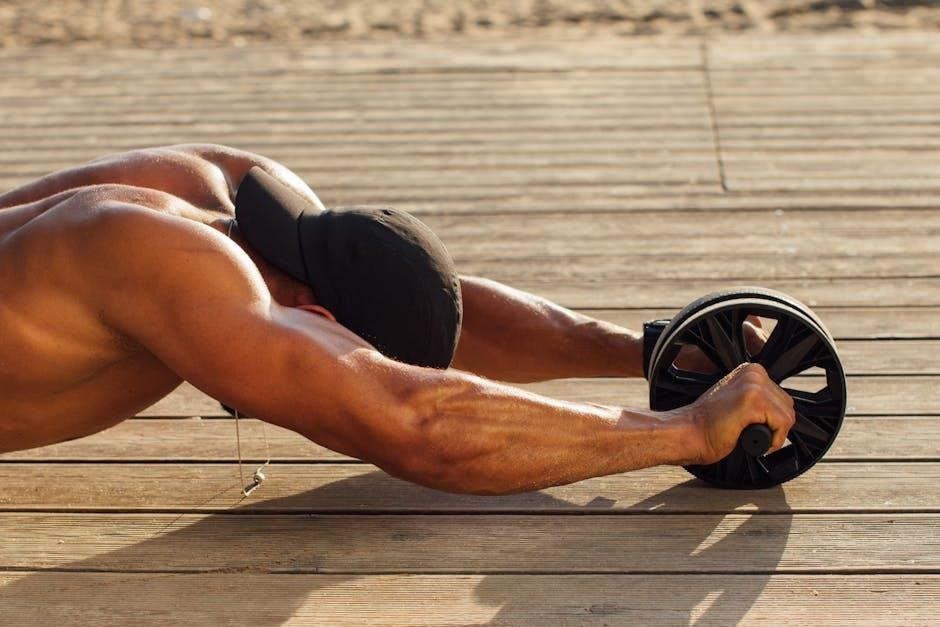Core strength training is essential for overall stability and functionality. It enhances posture, reduces injury risk, and improves athletic performance. Focusing on exercises like planks and crunches, it strengthens abdominal muscles, obliques, and lower back, forming a solid foundation for all physical activities.
1.1 Why Core Strength Matters
Core strength is the foundation of overall physical stability and functionality; It plays a crucial role in maintaining proper posture, reducing the risk of injuries, and enhancing athletic performance. A strong core, including abdominal muscles, obliques, and lower back, provides the stability needed for daily activities and sports. Weak core muscles can lead to poor posture, lower back pain, and reduced mobility. Strengthening the core improves balance, enhances movement efficiency, and supports proper breathing techniques. Additionally, it helps in transferring force between the upper and lower body, making it essential for activities like lifting, twisting, and bending. Neglecting core training can lead to muscle imbalances and poor functional movement patterns. Therefore, incorporating core exercises into a fitness routine is vital for long-term health, injury prevention, and optimal physical performance.
1.2 Benefits of Core Strength Training
Core strength training offers numerous benefits that extend beyond physical appearance. It significantly improves postural alignment, reducing the risk of back pain and injuries. Enhanced core stability boosts athletic performance by optimizing power transfer between the upper and lower body. Additionally, core training strengthens the abdominal muscles, obliques, and lower back, which are essential for maintaining balance and coordination. Regular core exercises also improve functional movement, making daily activities like lifting, bending, and twisting more efficient. Furthermore, a strong core enhances breathing techniques, which is crucial for overall respiratory health. By incorporating core workouts into a fitness routine, individuals can experience improved muscle endurance, better joint stability, and reduced fatigue during physical tasks. These benefits collectively contribute to a stronger, more resilient body capable of handling both daily challenges and high-intensity activities with ease.
1.3 Overview of Core Muscle Groups
The core comprises several key muscle groups that work together to provide stability, strength, and movement. The primary muscles include the abdominals, such as the rectus abdominis and transverse abdominis, which support the spine and facilitate movements like crunching and twisting. The obliques, both internal and external, play a crucial role in rotational movements and lateral bending. Additionally, the erector spinae and latissimus dorsi in the lower back contribute to posture, lifting, and overall structural support. These muscle groups function synergistically to maintain pelvic neutral, essential for preventing injuries and optimizing physical performance. Understanding the roles of these muscles helps in selecting exercises that target specific areas, ensuring a balanced and effective core training program.

Key Principles of Core Strength Training
Core strength training relies on proper breathing techniques, maintaining pelvic neutral, and applying progressive overload to build stability and power. These principles ensure safe, effective, and continuous improvement in core workouts.
2.1 Proper Breathing Techniques
Proper breathing is fundamental to effective core strength training. It ensures core stability and prevents injury by maintaining intra-abdominal pressure. Exhale during exertion, such as lifting or plank movements, to engage the transverse abdominis. Inhale during recovery phases to relax and recharge. This synchronized breathing enhances core contraction and overall performance. For example, in planks, exhale as you lower into position, and inhale upon release. Similarly, during dead bugs, exhale as you extend limbs and inhale as you return to the starting position. Consistent breathing patterns help maintain pelvic neutral and promote efficient muscle activation. Proper breathing techniques are essential for maximizing the effectiveness of core exercises and ensuring long-term progress in strength and stability training.
2.2 Maintaining Pelvic Neutral
Maintaining pelvic neutral is crucial for effective core strength training. It involves aligning the pelvis in a natural position, avoiding excessive arching or tucking, to ensure optimal core stability and prevent injury. This neutral alignment supports the spine and allows the core muscles to activate properly. During exercises like planks or dead bugs, focus on keeping the pelvis stable to maintain intra-abdominal pressure and engage the transverse abdominis. Proper pelvic alignment also enhances the effectiveness of leg raises and marches, ensuring targeting of the intended muscle groups. To achieve pelvic neutral, engage your core, relax your lower back, and ensure your hips are neither tilted forward nor back. This foundational posture is essential for maximizing the benefits of core exercises while minimizing the risk of strain or poor form.
2.3 Progressive Overload in Core Exercises
Progressive overload is a critical principle in core strength training, involving the gradual increase of exercise intensity to challenge muscles and promote growth. This can be achieved by increasing duration, resistance, or volume over time. For instance, extending the hold time in planks or adding weight to kettlebell swings enhances muscle engagement and strength. Incorporating weighted exercises, such as dumbbell marches or leg raises with weights, further intensifies core workouts. Additionally, increasing the number of repetitions or sets in exercises like crunches or farmers walks can progressively overload the core muscles. This method ensures continuous improvement, preventing plateaus and maximizing the effectiveness of core training. By systematically applying progressive overload, individuals can build a stronger, more resilient core that supports overall athleticism and functionality.

Core Anatomy and Physiology
The core comprises abdominal muscles, obliques, and lower back muscles, working together to provide stabilization and support for the body. These muscle groups enable efficient movement and maintain spinal alignment, essential for overall physical function and athletic performance.
3.1 Major Core Muscles: Abs, Obliques, and Lower Back
The core is composed of several key muscle groups, each playing a unique role in stability and movement. The abdominals include the rectus abdominis, responsible for flexion, and the transverse abdominis, which acts as a deep stabilizer. The obliques, both internal and external, facilitate rotational movements and lateral flexion. The lower back muscles, such as the erector spinae, support spinal extension and posture. Together, these muscles form a dynamic system that enables efficient movement, protects the spine, and enhances overall athletic performance. Strengthening these muscles through targeted exercises like planks and dead bugs improves core stability and reduces injury risk. Understanding their functions and integrating them into a training program is essential for building a strong, functional core.
3.2 The Role of the Diaphragm in Core Stability
The diaphragm plays a crucial role in core stability by working in conjunction with the abdominal muscles. During proper breathing, the diaphragm descends, increasing intra-abdominal pressure and providing a stable base for the spine. This mechanism is essential for maintaining pelvic neutral and preventing excessive movement during exercises. The diaphragm’s contraction helps activate the transverse abdominis, the deepest abdominal muscle, which wraps around the spine for protection. When breathing techniques are synchronized with core exercises, such as planks or dead bugs, the diaphragm enhances stability and reduces the risk of injury. Proper engagement of the diaphragm ensures that the core functions as a unified system, optimizing both strength and functionality. This integration of breathing and movement is fundamental to effective core training and overall physical performance.
3.3 Understanding Muscle Fiber Types for Core Training
Understanding muscle fiber types is crucial for effective core training. The human body contains primarily two types of muscle fibers: Type I (slow-twitch) and Type II (fast-twitch). Type I fibers are endurance-based, providing sustained contractions over time, which is essential for core stability exercises like planks and dead bugs. Type II fibers are designed for strength and power, making them vital for dynamic core movements such as crunches and leg raises. Core training targets both fiber types to enhance overall functionality. For example, isometric exercises like planks engage Type I fibers, while explosive movements like kettlebell swings recruit Type II fibers. Balancing the development of both fiber types ensures a robust and versatile core. This understanding allows individuals to tailor their workouts, incorporating exercises that challenge both endurance and strength, leading to improved core performance and overall athleticism.

Phases of Core Strength Training
Core strength training is divided into three phases: foundation, strength, and advanced. Each phase builds on the previous, starting with stability, progressing to power, and ending with functional integration for peak performance.

4.1 Phase 1: Foundation and Stability
Phase 1 focuses on building a solid foundation of core stability and awareness. This stage is crucial for beginners or those recovering from injuries. It emphasizes proper breathing techniques, pelvic neutral positioning, and basic exercises like planks, bird dogs, and pelvic tilts. These exercises strengthen the deep core muscles, improve posture, and enhance overall stability. The goal is to establish a strong, injury-resistant base before progressing to more challenging movements. Duration and control are prioritized over intensity, with exercises often held for 10-20 seconds to build endurance. This phase also introduces the concept of bracing and engages the diaphragm to ensure proper core activation. By mastering these fundamentals, individuals can safely advance to more dynamic and strength-building exercises in later phases.
4.2 Phase 2: Building Strength and Power
Phase 2 shifts focus to developing strength and power in the core muscles. This stage introduces more dynamic exercises, such as weighted crunches, leg raises, and kettlebell swings, to challenge the abs, obliques, and lower back. Farmers walks and dead bugs are also incorporated to enhance functional strength and grip stability. The emphasis is on progressive overload, gradually increasing resistance or intensity to build muscle endurance and power. Proper form and controlled movements are crucial to avoid injury and maximize results. This phase also integrates exercises that improve coordination and balance, preparing the body for more advanced movements. By strengthening the core, individuals can enhance their overall athletic performance and everyday functionality. The goal is to create a powerful, resilient core that supports both physical activity and long-term health.
4.3 Phase 3: Advanced Core Stability and Functionality
Phase 3 focuses on advancing core stability and functionality through complex, dynamic exercises. This stage introduces movements that challenge the core in multiple planes, such as rotational exercises, single-arm planks, and dynamic rotations. Functional training tools like balance boards or wobble cushions are often incorporated to enhance balance and coordination. Plyometric exercises, such as medicine ball throws and explosive rotations, are added to improve power and reactivity. The emphasis is on integrating core strength into full-body movements, ensuring the core stabilizes and drives complex actions. Proper form and pelvic neutral alignment remain critical to prevent injury. This phase prepares individuals for high-level physical performance, bridging the gap between core strength and real-world functionality. By mastering these advanced techniques, individuals achieve a highly functional and resilient core that supports elite-level athleticism and everyday activities with ease.

Effective Core Strengthening Exercises
Core exercises like planks, crunches, and leg raises target the abdominals, obliques, and lower back. These movements enhance stability, strength, and functionality, forming the foundation for a strong, injury-resistant core.
5.1 Bodyweight Exercises: Planks, Crunches, and Leg Raises
Bodyweight exercises are fundamental for building core strength. Planks are excellent for improving stability and endurance, targeting the abdominals, obliques, and lower back. They can be modified, such as side planks or incline planks, to vary intensity. Crunches focus on the rectus abdominis, enhancing abdominal strength and definition. Proper form is crucial to avoid neck strain. Leg Raises target the lower abdominals, improving hip flexor mobility and core stability. Perform these exercises with controlled movements to maximize effectiveness. Incorporating variations, such as weighted crunches or hanging leg raises, can increase difficulty. These exercises are versatile, requiring no equipment, making them ideal for home workouts. Consistency and proper form are key to achieving results and preventing injury. They form the cornerstone of a well-rounded core training program, enhancing overall strength and functionality.
5.2 Weighted Exercises: Kettlebell Swings and Dumbbell Marches
Weighted exercises like kettlebell swings and dumbbell marches are excellent for building core strength and power. Kettlebell swings engage the entire core, improving posture and enhancing explosive power. They require proper form, with a hinge movement at the hips, to avoid injury. Dumbbell marches involve holding a dumbbell while maintaining a plank position, promoting core stability and unilateral strength. These exercises challenge the abdominals, obliques, and lower back, improving overall core functionality. Incorporating weights increases resistance, making the workouts more intense. Both exercises are versatile and can be adapted to different fitness levels. Consistency in performing these weighted exercises helps build a stronger, more resilient core, which is essential for both athletic performance and daily activities. They are key components of a well-rounded core training program, offering both strength and functional benefits.
5.3 Functional Exercises: Farmers Walk and Dead Bugs
Functional exercises like the farmers walk and dead bugs are highly effective for enhancing core strength and stability. The farmers walk involves carrying heavy weights while maintaining proper posture, which engages the entire core, improves grip strength, and boosts cardiovascular endurance. It is versatile, fitting into upper-body, lower-body, or core-focused workout days. On the other hand, dead bugs target the deep abdominal muscles by alternating leg and arm movements while maintaining pelvic neutral. This exercise enhances core stability, promotes muscle balance, and reduces the risk of lower back pain. Both exercises mimic real-life movements, making them functional and practical for everyday activities. Incorporating these into a core training routine improves overall strength, stability, and athleticism. They are ideal for those seeking to build a strong, resilient core with actionable results in both fitness and daily life.

Accessories for Core Training
Accessories like resistance bands, exercise balls, and foam rollers enhance core workouts. They add challenge, improve stability, and aid in muscle recovery for better overall results.
6.1 Breathing Techniques for Core Stability
Proper breathing is crucial for core stability, as it helps maintain intra-abdominal pressure and pelvic neutral. Exhale during exertion, such as lifting or crunching, to engage the core muscles effectively. Inhale during recovery phases to replenish oxygen and relax the muscles. Avoid holding your breath, as it can increase pressure and reduce stability. Practice diaphragmatic breathing to activate the transverse abdominis muscle, which wraps around the spine and pelvis, providing a natural brace. This technique involves expanding the belly rather than shallow chest breathing. Consistent practice of these breathing patterns enhances core stability and improves overall exercise performance. Proper breathing also reduces the risk of injury and ensures efficient muscle activation during core exercises like planks, crunches, and leg raises. Remember, breath control is the foundation of effective core training and should be prioritized in every workout.
6.2 Incorporating Progressive Overload in Core Workouts
Progressive overload is vital for advancing core strength and avoiding plateaus. Start with bodyweight exercises like planks and crunches, then gradually increase resistance using weights or resistance bands. For example, add a weighted vest to planks or use a dumbbell during leg raises. Repetition range can also be adjusted; perform 8-15 reps for strength or 15-20 reps for endurance. Incorporate dynamic movements, such as kettlebell swings or medicine ball throws, to build power. Rest periods should be minimized to enhance muscular endurance. Over time, increase the intensity by extending hold times for exercises like hollow body holds or increasing the weight used. This systematic approach ensures continuous improvement in core stability, strength, and functionality. Remember, consistency and gradual progression are key to achieving long-term core strength gains and overall athletic performance.

Recovery and Maintenance
Rest days are crucial for core recovery, allowing muscles to repair and strengthen. Incorporate foam rolling and stretching to enhance flexibility and reduce muscle tension. Proper breathing techniques also aid in muscle recovery and overall well-being.
7.1 Importance of Rest Days for Core Recovery
Rest days are vital for core recovery, allowing muscles to repair and rebuild. Overtraining can lead to fatigue and injury, undermining progress. During rest, your body strengthens the muscles you’ve worked, enhancing endurance and stability. Consistency in training is key, but so is giving your body time to heal. Neglecting rest days can result in poor form and reduced performance. Incorporating rest ensures your core muscles recover fully, making your workouts more effective. A balanced approach to training and recovery is essential for achieving long-term core strength and overall well-being. Remember, rest is not inactivity—it’s an active part of your training process.
7.2 Foam Rolling and Stretching for Core Muscles
Foam rolling and stretching are essential for maintaining healthy core muscles. Foam rolling improves blood flow, reduces muscle tension, and enhances recovery after workouts. It targets areas like the lower back and hips, which are critical for core stability. Stretching, on the other hand, increases flexibility and prevents tightness, allowing for better range of motion during exercises. Dynamic stretches, such as leg swings and torso twists, are ideal for warming up, while static stretches, like child’s pose and hamstring stretches, help cool down. Incorporating these practices regularly can improve posture, reduce muscle soreness, and support overall core function. For optimal results, spend 5-10 minutes foam rolling and stretching after each core session. Consistency ensures your muscles remain supple and prepared for future training. These recovery tools are vital for a well-rounded core strength program.
Core strength training is vital for improving posture, reducing injury risk, and enhancing overall physical performance. Regular practice of exercises like planks and crunches strengthens core muscles, boosting stability and endurance. Incorporating this training into your routine ensures a strong foundation for all activities, making it essential for long-term health and fitness.
8.1 Summary of Core Strength Training Benefits
Core strength training offers numerous benefits, including improved posture, enhanced athletic performance, and reduced injury risk. It strengthens abdominal muscles, obliques, and the lower back, providing stability for daily activities and sports. By building a strong core, individuals can achieve better balance and coordination, which are essential for overall physical fitness. Regular core workouts also improve functional movement, making tasks like lifting or bending easier. Additionally, a strong core enhances respiratory efficiency and supports proper pelvic alignment, reducing the strain on other muscle groups. These benefits make core training a fundamental component of any exercise program, whether for athletes or individuals seeking general wellness. Consistent practice ensures long-term improvements in strength, stability, and overall health.
8.2 Encouragement to Start or Continue Core Training
Embracing core strength training is a transformative step toward a stronger, healthier you. Whether you’re a beginner or an experienced athlete, incorporating core exercises into your routine can yield significant improvements in balance, posture, and overall physical performance. The journey begins with simple moves like planks and crunches, which lay a solid foundation for more advanced workouts. The benefits extend beyond aesthetics, enhancing functional movement and reducing injury risks. For those already committed, continuing to challenge your core with progressive overload and diverse exercises ensures sustained progress. Remember, consistency is key. Even a few minutes daily can lead to noticeable changes over time. So, take the first step or keep pushing forward—your core, and your body, will thank you. Start today and unlock a stronger, more resilient version of yourself!
